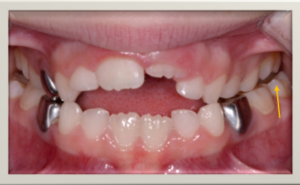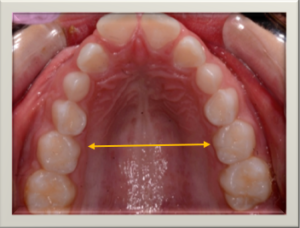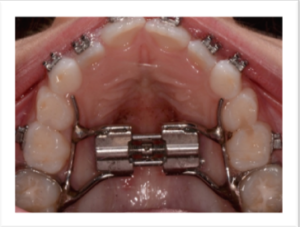
What Orthodontic Expanders Do and Why Your Child Might Need One
by Dr. Laura Milnor
Orthodontists don’t only treat patient with braces or Invisalign. In fact, before these treatments will even be beneficial to a smile, we can start improving a child’s oral health with the use of palatal expanders.
Issues a Palatal Expander Can Fix
If you take your child to the orthodontist, which you should do around age 7, a palatal expander may be recommended. One main indication for an expander is the presence of a posterior cross-bite, shown below.
A posterior cross-bite is when the upper back teeth come down (occlude) inside the lower back teeth. This relationship is very hard on the teeth and will lead to excess wear and tear over time.
The other primary time an expander will be used is when the upper jaw (maxilla) is too narrow, and/or your child suffers from a sleep apnea type of disorder.
When the upper jaw is narrow, it is very common to also have a posterior cross-bite, so using an expander corrects both these problems.
Why It’s Important to Have an Orthodontic Expander at a Young Age
Expanders that are cemented in and require a parent to turn a screw will actually widen the upper jaw skeletally. The ideal time to start treatment is when the patient is still growing, ideally between ages 7 and 10. This ensures the growth suture in the palate can still be expanded. Once growth is complete, we lose the opportunity to use an expander, and true skeletal change will require jaw surgery.
Most patients between 11 and 14 will still be able to successfully have an expander, but occasionally the growth suture is already closed by this age. In addition to the correction of the above problems, expanders can also help decrease air resistance in the nasal cavity and make additional space for crowded teeth and improved tongue position.
How Orthodontic Expanders Work
This is an example of a typical expander used for skeletal expansion:
This appliance is activated by a parent turning the expansion screw at a frequency determined by your orthodontist. Once the optimal expansion has been achieved the appliance typically stays in place for six months to allow the jaw expansion to become more permanent.
The lower jaw cannot be expanded in this fashion as the suture is fused from birth. Luckily, the lower arch typically just requires dental expansion, which can be accomplished with braces or removable retainers. This means we can still develop broader arches, but the extent to which we can widen the arch is more limited. The appropriate mechanism to achieve expansion will be determined by your orthodontist.
To find out if your child would benefit from a palatal expander, take them to see an orthodontist at age 7. Many orthodontists, including myself, offer a free initial exam, and will continue to monitor your child’s tooth and jaw development free of charge until treatment is needed.
At Milnor Orthodontics, our experts are here to help you achieve a priceless smile. Call our office at (970) 484-3214 or visit milnororthodontics.com to learn more. We're located at 1103 S. Shields St. in Fort Collins, Colorado.










